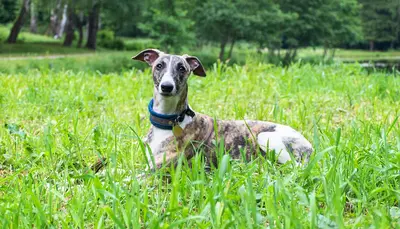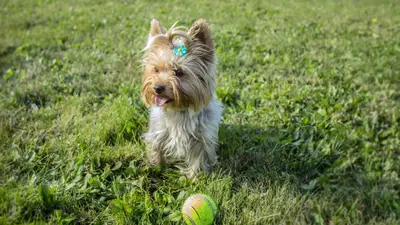Australian Shepherd: Breed Guide
- 24 Apr 2025
- 11m read

The Australian Shepherd, or Aussie for short, is a four-legged firecracker bursting with brains, energy and charm. Despite what their name suggests, these dogs didn’t come from Down Under – they’ve got all-American roots, and a strong work ethic to match. Whether they’re rounding up sheep or ruling the agility ring, Aussies are born to impress.
Australian Shepherd Origin
Despite being called “Australian,” this breed was actually developed in the United States. The confusion? Well, their ancestors included herding dogs brought over from Australia and New Zealand, which is where the name stuck. But make no mistake – the Aussie is as American as apple pie (with a lot more zoomies).
The beginning
Herding dogs made their way to North America in the 16th century, used to manage sheep and cattle. Their appearance varied depending on region and role, but all shared one key trait: they loved to work.
Development of the breed
Aussies gained their greatest popularity after World War II, thanks to the emergence of the fashion for western riding shows organized during horse shows and rodeos. Jay Sisler, a famous dog trainer, contributed particularly to the promotion of Australian Shepherds, who often performed with his well-trained dogs at shows. A pair of dogs bred by him, Shorty and Stub, also appeared in Disney films and became the ancestors of most of today's Aussies.
In 1957, the first American breed club, the Australian Shepherd Club of America (ASCA), was founded and stud books were started. Members of this organization opposed the recognition of the breed by the American Kennel Club, fearing that in the hands of breeders associated with the AKC, the dogs would lose their utility traits. However, thanks to the United States Australian Shepherd Association (USASA), in 1993, Australian Shepherds were registered with the AKC, and the FCI recognized the existence of the breed in 1996.
Currently
Currently, Australian Shepherds from working lines are still excellent herding dogs and are often chosen by cattle and sheep farmers . Intelligent and eager to work, these dogs have also gained huge popularity among people practicing cynological sports. Aussies can be found, among others, in obedience and agility competitions, they are also good in rescue, uniformed services and dog therapy.
What Were Australian Shepherds Bred For?
Despite their fun-loving nature and Insta-worthy good looks, Australian Shepherds weren’t bred to be lap dogs. Nope – these clever canines were originally bred for herding livestock. With their sharp smarts, endless stamina and an eye for order, they excelled at rounding up sheep, cattle, and pretty much anything with hooves. Their natural instinct to herd can still be seen today – whether it’s keeping the kids in check or chasing after squirrels in the park.
Australian Shepherd Breed Group
The Aussie belongs to the Herding Group, a category that’s all about work ethic, intelligence, and loyalty. These dogs were made to move – not just physically, but mentally too. They love having a job to do, and they'll thrive in homes where they’re given the chance to use their brains and brawn every day.
Australian Shepherd Ideal Owner
Aussies aren’t for everyone. These pups need owners who are ready to put in time, training, and a whole lot of love. They’re the perfect fit for active, outdoorsy people who enjoy adventures, challenges and a dog that doubles as a shadow. First-time dog parents might find them a bit full-on.
Australian Shepherd Size
Aussies are medium-sized dogs with well-balanced bodies built for agility, endurance and zoomies. Males tend to be slightly more muscular than females, but both should move with effortless grace.
The head of the Australian Shepherd should be strong with a flat skull with a distinct stop and a slightly tapering, rounded muzzle at the end. The eyes of this breed must be almond-shaped, with a sharp and intelligent expression. The ears of the Australian Shepherd should be triangular, medium-sized and thick, and bent forward.
The body of this breed should be strong, the back straight and even, and the chest not too wide but deep, with well-sprung ribs. In the Australian Shepherd breed, dogs with a naturally short tail, no longer than 10 cm, are preferred, although dogs with a naturally long tail are also accepted. The limbs of the Aussie should be straight, strong and well-muscled. The dog of this breed should move with a free movement that does not require any effort from the dog.
How Big Do Australian Shepherds Get?
Male Australian Shepherds usually stand between 51–58 cm (20–23 inches) at the shoulder, while females are a bit daintier at 46–53 cm (18–21 inches).
How Much Should an Australian Shepherd Weigh?
On average, adult male Aussies weigh 25–32 kg (55–70 lbs), and females typically tip the scales at 18–25 kg (40–55 lbs).
When Do Australian Shepherds Stop Growing?
Australian Shepherds reach their full height at around 12–16 months, but they’ll keep filling out (and maturing emotionally) until about 2 years old. So if your pup still acts like a bouncing furball of energy after their first birthday, don’t worry – that’s totally normal!
Australian Shepherd Coat
Aussies have a weather-resistant, double-layered coat that’s both stunning and practical. They come in a range of gorgeous colours – including blue merle, red merle, black, and red – often with white markings or tan points. Their nose, lips, and eyelids should match their coat, and eye colour can range from brown to blue, or even one of each (how cool is that?).
Do Australian Shepherds Shed?
Oh yes – Aussies shed, and they shed a lot.
While they’re not the most high-maintenance dogs in the grooming world, you’ll definitely notice tufts of fur popping up like confetti during shedding seasons (spring and autumn especially). A regular brushing routine helps keep the fluff under control – and your sofa slightly less hairy.
Are Australian Shepherds Hypoallergenic?
Sadly, no. Aussies are not hypoallergenic. They produce the dander and loose hair that can trigger allergies, so if you’re sneeze-prone or sensitive to allergens, this may not be your perfect match.
How to Groom an Australian Shepherd
Their dense, double-layered coat provides good protection against frost, wind, and moisture, making the Aussie quite resistant to adverse weather conditions.
Regular brushing is enough to remove excess dead undercoat and untangle the knots that often form behind the ears, in the groin and around the tail. Poodle brushes, metal combs and furminators work best when brushing the Aussie. The Aussie does not need frequent baths. After a walk, the dog is simply wiped with a damp cloth or combed dry to remove any remaining mud or dirt from the coat.
However, if your dog gets really dirty, you should bathe him with a hypoallergenic shampoo designed for dogs with sensitive skin , and after washing, squeeze him out with a towel and dry him with a hair dryer set on a cool setting.
The owner of an Australian Shepherd must also maintain the hygiene of the dog's eyes and ears. If the eyes or ears of the Aussie become red or have discharge, consult a vet. It is also a good idea to regularly check the condition of the dog's teeth and claws.
Australian Shepherd Personality
Aussies are clever, loyal and bursting with energy. They love their humans, thrive on structure, and like being in the thick of things. Some can be wary of strangers or aloof with other dogs, but a well-socialised Aussie is usually confident and kind.
Are Australian Shepherds Good Family Dogs?
Australian Shepherds, like German Shepherds or Shetland Sheepdogs , are extremely devoted to their owners, they like to show them their affection and accompany them in everyday activities. They can be good playmates for slightly older children who have been taught how to behave around dogs.
It is important to remember, however, that Aussies have a strong herding instinct , which can make them prone to herding and painfully nipping running children. They can also become rough during exciting play, so their contact with children should always be supervised by an adult.
Some Australian Shepherds may also have a strong guarding instinct and be distrustful of strangers . They should not be aggressive, but they will do well as a home guard. Dogs of this breed should not live exclusively in the garden - deprived of contact with family members, they can become frustrated and problematic, or even aggressive.
Australian Shepherds are not always fond of other dogs and would much rather be with their owners than play with other dogs. A well-socialised Aussie should not be aggressive, however. If your Aussie starts to show aggressive behavior, becomes reactive, or overly excited around other dogs, you should consult an experienced behaviourist.
Are Australian Shepherds Easy to Train?
Aussies are active, lively dogs that are eager to cooperate with their owner . Thanks to their great intelligence, they quickly learn even very complicated commands and perform them with great commitment. They are excellent in various cynological sports, such as obedience, agility, dog frisbee, sheep herding, dancing with a dog or tracking.
When training a dog of this breed, you should not use aversive methods such as punishment, shouting or physical violence - it works much better to train by rewarding the dog for appropriate behaviour.
Do Australian Shepherds Bark a Lot?
They sure can. Aussies are vocal and love to share their thoughts – whether it’s about visitors, birds, or the wind. With the right training and stimulation, you can manage the barking and teach them when it’s okay to sound the alarm.
Are Australian Shepherds Intelligent?
In short: yes, yes, and absolutely yes. Australian Shepherds are one of the smartest breeds around.
They don’t just learn tricks – they learn routines, solve problems, and can often outsmart their humans (yep, we said it). This brainy bunch needs regular mental workouts to stay happy, so puzzle toys, new commands, and interactive games are a must. A bored Aussie is basically a furry genius without a job – and that can spell trouble for your sofa cushions.
Can Australian Shepherds Be Left Alone?
Being alone isn’t an Aussie’s idea of a good time. These pups form strong bonds with their humans and can get anxious or destructive if left solo for too long.
A couple of hours here and there is usually fine – especially with toys and treats to keep them busy – but they’re not well-suited to homes where they’ll be left alone all day, every day. Doggy daycare, dog walkers, or a four-legged sibling can help keep your Aussie company if you’re out and about a lot.
Can Australian Shepherds Swim?
Many Aussies can swim, and some even love it – but not all.
Unlike breeds built for the water, Aussies don’t have webbed feet or water-resistant coats, so not every one will be a natural paddler. If your pooch enjoys a splash, introduce swimming gradually in safe, shallow water and keep a close eye on them. And don’t forget a doggy life jacket if you’re heading out on the open water!
Australian Shepherd Exercise
The Australian Shepherd is not a couch potato. It requires a lot of exercise, long and interesting walks combined with free exploration of the surroundings and interesting exercises. Boredom and lack of physical activity will lead to frustration and reactivity, which will become very burdensome for the owners.
How Much Exercise Does an Australian Shepherd Need?
Aussies need at least 1.5 to 2 hours of physical exercise a day, and that’s not including mental stimulation. Long walks, puzzle toys, obedience games, and time off-lead in a secure space will all keep their tails wagging.
Australian Shepherd Health
The risk of certain ailments in Aussies can be reduced by purchasing a puppy from a breeder registered with the Kennel Club (FCI). Responsible breeders only allow tested dogs to reproduce, which will not pass on defective genes to their offspring. They also test puppies before sale and inform potential owners about health problems typical of the breed.
Are Australian Shepherds Prone to Any Health Conditions?
Australian Shepherds are prone to several ailments, such as:
Collie Eye Anomaly (CEA),
retinal dysplasia,
progressive retinal atrophy (PRA),
double row of eyelashes,
cataract,
hip dysplasia ,
patella dislocation,
hypothyroidism,
MDR1 gene mutation resulting in hypersensitivity to certain drugs,
epilepsy,
hypersensitivity of the skin of the nose to the sun.
Australian Shepherd Cost
Falling in love with an Aussie is easy – but it’s worth knowing that welcoming one of these energetic, intelligent pups into your life comes with a price tag.
How Much Does an Australian Shepherd Cost?
The price of an Australian Shepherd puppy from a reputable breeder can vary, but expect to pay anywhere from £800 to £1,500 in the UK. Show lines or rare colours can cost more. But the real cost goes beyond the puppy price tag – food, grooming, vet care and training all add up over the years.




